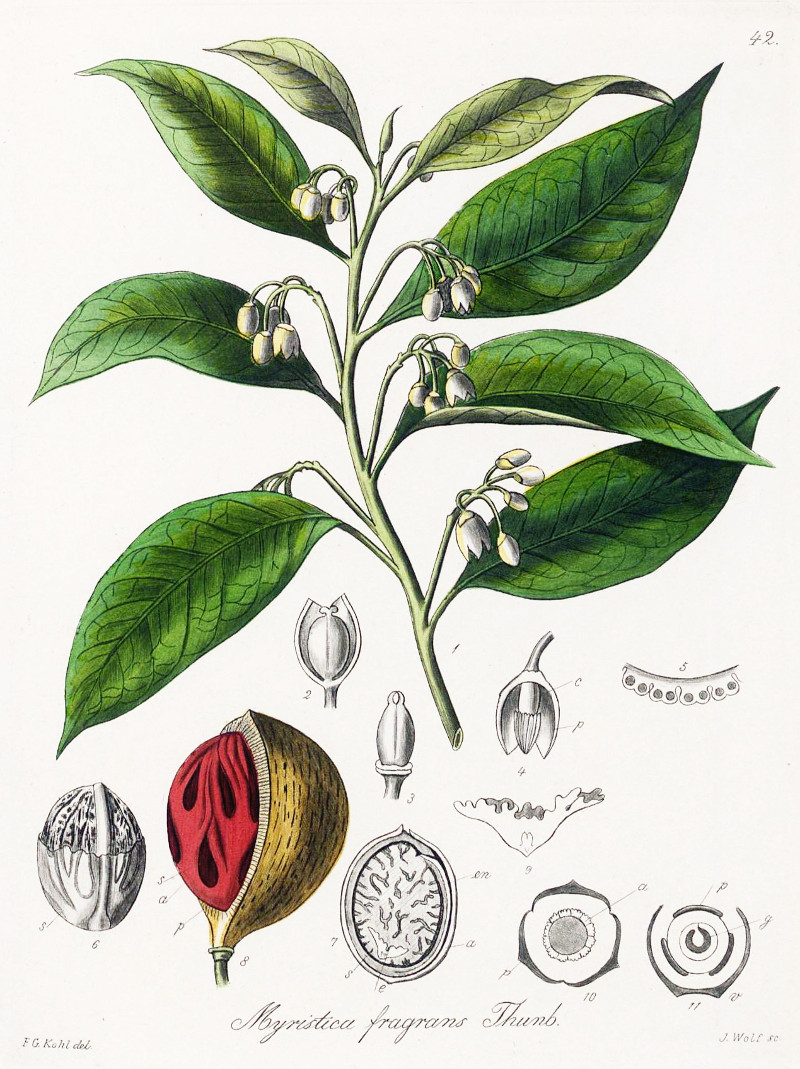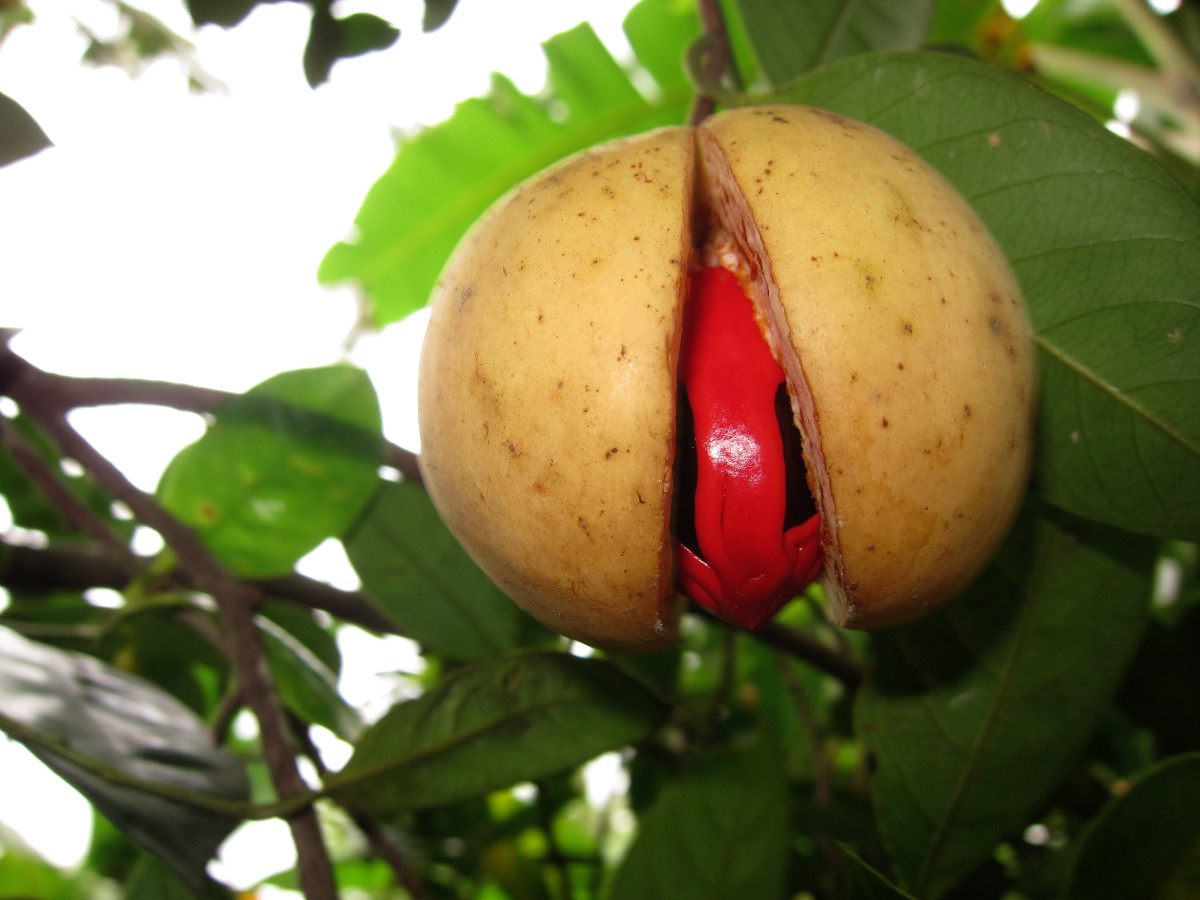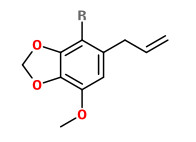Myristica fragrans Houtt. - syn. Myristica officinalis L. - Myristicaceae - mace, nutmeg (tree), Muskatnuss (-baum)
Evergreen tree, up to 15m tall, native to the Molucca Islands; introduced and cultivated in Southeast Asia and Mauritius.
The fruits of the tree are important as the source of the spices nutmeg (germ. Muskatnuss) and mace (germ. Macis).
„Nutmeg is not a nut, but the kernel of an apricot-like fruit. Mace is an arillus, a thin leathery tissue between the stone and the pulp; it is bright red to purple when harvested, but after drying changes to amber… Both spices are strongly aromatic, resinous and warm in taste. Mace is generally said to have a finer aroma than nutmeg, but the difference is small. Nutmeg quickly loses its fragrance when ground; therefore, the necessary amount should be grated from a whole nut immediately before usage.“ http://gernot-katzers-spice-pages.com/engl/Myri_fra.html
„In addition to about 40 percent fatty oil (with the triglyceride of myristic acid as the main constituent) nutmeg also contain about 25 percent starch, as well as resins. The fatty oil is also known as nutmeg butter because of its butter-like consistency.“ http://de.wikipedia.org/wiki/Muskatnussbaum#Inhaltsstoffe
An extract of nutmeg (liquid CO2; 90 bar, 296K) contained fatty oils (36.4-57.4% with mainly saturated fatty acids, thereof myristic acid 40%) and essential oil. Major components of the essential oil fraction were sabinene (36.6%) β-pinene (10.1%), α-pinene (11.0 %), and myristicin (6.9%), with safrole (1.0%).
[Extraction of essential oil and lipids from nutmeg by liquid carbon dioxide., Spricigo, C.B., Pinto, L.T., Bolzan, A., Novais, A.F., The Journal of supercritical fluids, 15(3), 253-259, 1999]
„The essential oil is known to have spasmolytic activity and relieves stomach cramps and flatulence. The addictive and hallucinogenic effects are ascribed to myristicin and elemicin that are converted to amphetamin-like compounds [in the body].“
[Medicinal Plants of the World. Ben-Erik Van Wyk and Michael Wink, Pretoria 2004, 210]
„The essential oil content ranged from 3.9% (A9/116) to 16.5% (A9/18) (v Iw) in nutmeg and 6% (A9/107) to 26.1% (A9/18) in mace… Myristicin content ranged from 1.1 % (A9/20) to 45.6% (A11/21) in nutmeg oil and 0.21% (A9/13) to 36.6% (A4/117) in mace oil; the elemicin content ranged from 1.0% (A4/22) to 29.7% (A11/26) in nutmeg oil and 1.0% (A9 II) to 30.2 % (A4/12) in mace oil. Safrole content ranged from 0.1% (A9/11) to 22.1% (A9/13) in essential oil and 0.2% (A9 Ill) to 21.8% (A9/13) in mace oil.“
[Maya, K. M., T. John Zachariah, and B. Krishnamoorthy. „Chemical composition of essential oil of nutmeg (Myristicafragrans Houtt.) accesc sions.“ Journal of Spices and Aromatic Crops 13.2 (2004): 135-139] https://updatepublishing.com/journals/index.php/josac/article/download/612/574
„An amount of 4.92 g of the essential oil was obtained from 100 g of nutmeg [three-hour hydrodistillation]. Major components of nutmeg oil are terpenes, terpene alcohols and phenolic ethers. The monoterpene hydrocarbons, β-pinene (23.9 %), α-pinene (17.2 %), and limonene (7.5 %), constituted the main fraction of nutmeg oil. The major phenolic ether is myristicin (16.2 %), accompanied by safrole (3.9 %) and methyl eugenol (1.8 %).“
The main aglycones of glycosidically bound volatiles identified in nutmeg are isoeugenol (46.1 %) and methoxyeugenol (27.7 %).
[Chemical composition and antioxidant effect of free volatile aglycones from nutmeg (Myristica fragrans Houtt.) compared to its essential oil., Jukić, M., Politeo, O., Miloš, M., Croatica chemica ACTA, 79(2), 2006, 209-214] http://hrcak.srce.hr/file/6795
Essential oil content in nutmeg seeds is 5 to 10%, with propylbenzene derivatives and terpenes as major components.
Chemical composition of essential oil of nutmeg seeds (32 compounds): myristicin (13%), safrole (4%), isoeugenol (1%), elemicin (1%); sabinene (21%), 4-terpineol (13%), α-pinene (10%), limonene (5%), γ-terpinene (4%), α-terpineol (3%).
[Identification of compounds in the essential oil of nutmeg seeds (Myristica fragrans Houtt.) that inhibit locomotor activity in mice. Muchtaridi, Anas Subarnas , Anton Apriyantono, Resmi Mustarichie, Int. J. Mol. Sci. 2010, 11, 4771-4781]
„Nutmeg oil was extracted from nutmeg seed at pressures of 15-20 MPa and temperatures of 313-323 K with supercritical CO2…Nutmeg oil extracted contained terpene hydrocarbons (such as phellandrene, pinene, camphene, myrcene, limonene, carene and camphene), terpene derivatives (such as linalyl butanoate, α-cubebene, copaene, asarone and anthrone) and myristicin as the main components. The composition of terpene hydrocarbons, terpene derivatives and myristicin were 44.85%, 7.23%, and 31.55%, respectively.“
[Supercritical CO2 extraction of nutmeg oil: Experiments and modeling. Siti Machmudah, Anny Sulaswatty, Mitsuru Sasaki, Motonobu Goto, Tsutomu Hirose, The Journal of Supercritical Fluids, Vol.39 (1), 2006, 30-39]
The quality description of a commercial CO2 extract of 100% natural material demands essentail oil 75-90%, myristicin 10-30%, safrole 1-4%.
[Macis CO2-se Extrakt Typ Nr. 001.001, Flavex Corp. 2014] http://www.flavex.com/fileadmin/flavex.de/user_upload/Spezifikation/Deutsch/Spezi_Macis_CO2-se_Extrakt_001_001.pdf
Mace has been used in Indonesian folk medicine as aromatic stomachics, analgesics and for rheumatism. The antiinflammatory activity of it was investigated on carrageenin-induced edema in rats and acetic acid-induced vascular permeability in mice. A fraction containing mainly myristicin showed a lasting antiinflammatory activity, and the potency of these fraction were approximately the same as that of indomethacin (10 mg/kg). „These results suggest that the antiinflammatory action of Mace is due to the myristicin that it contains.“
[Antiinflammatory effect of mace, aril of Myristica fragrans Houtt., and its active principles., Ozaki, Y., Soedigo, S., Wattimena, Y.R., Suganda, A.G., The Japanese Journal of Pharmacology, 49(2), 1989, 155-163]
The contamination of traded nutmeg with aflatoxins (AFs: AFB1, AFB2, AFG1, AFG2) is a serious problem. Of 13 edible and medicinal nutmeg samples marketed in China, four were detected with contamination of AFs and one with ochratoxin A (OTA). „AFB1 was the most frequently found mycotoxin in 30.8% of nutmeg samples at contamination levels of 0.73–16.31 μg kg−1.“
[Simultaneous multi-mycotoxin determination in nutmeg by ultrasound-assisted solid–liquid extraction and immunoaffinity column clean-up coupled with liquid chromatography and on-line post-column photochemical derivatization-fluorescence detection., Kong, W.J., Liu, S.Y., Qiu, F., Xiao, X.H., Yang, M.H., Analyst, 138(9), 2013, 2729-2739]

Kohl,F.G., Die officinellen Pflanzen der Pharmacopoea Germanica, t.42 (1891-1895)
http://plantgenera.org/species.php?id_species=688009

Myrista fragrans, ripe fruit
CC BY-SA 3.0, Author: കാക്കര Wikimedia Commons






